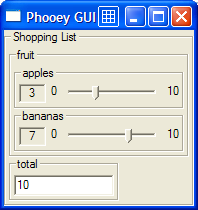Applicative data-driven programming
I would love to get comments on a short (4.5 page) paper draft. It describes a very simple approach to data-driven computation and its application to GUI programming. Please use the Talk page for comments, or if you prefer you could email me instead.
I'm also very interested in suggestions or (better yet) collaboration on other applications of data-driven computation beyond GUIs, say internet-based.
Abstract
- Graphical user interfaces (GUIs) are usually programmed in an "unnatural" style, in that implementation dependencies are inverted, relative to logical dependencies. We suggest that this reversal results directly from the imperative, data-driven orientation of most GUI libraries. While outputs depend on inputs from a user and semantic point of view, the data-driven approach imposes an implementation dependence of inputs on outputs.
- This paper presents simple, functional interfaces for data-driven programming in general and GUI programming in particular, in which program dependencies directly mirror logical dependencies. The interfaces are structured as applicative functors (AFs), rather than monads or arrows. Efficiency is retained while abstracting the mechanics of data-driven computation out of client programs and into reusable library code. The implementations of data-driven computation and of GUIs are also quite simple, largely due to structuring them as compositions of AFs.
Files
- Paper (181K PDF)
- Literate source (9K .tar.gz)
Preview
Using "g `O` f" for the composition of type constructors g and f, the representation of data-driven computations is simply as follows:
type Source = (,) (IO () -> IO ()) `O` IO(The paper generalizes this definition considerably.)
And of GUIs:
type UI = (->) Win `O` IO `O` (,) Layout `O` SourceThese types are isomorphic to the following:
type Source' a = (IO () -> IO (), IO a)
type UI' a = Win -> IO (Layout, Source' a)The advantage of the former definitions is that Source and UI are automatically both applicative functors, and so their values may be constructed from primitives via pure, <*>, and derived functions.
The paper also provides a more general notion of data-driven sources, as well as a more efficient version of Source and a version of UI that supports flexible layouts.
Example GUI:
and corresponding code:
apples, bananas, fruit :: UI Int
apples = title "apples" $ islider (0,10) 3
bananas = title "bananas" $ islider (0,10) 7
fruit = title "fruit" $ liftA2 (+) apples bananas
total :: UI (Int -> IO ())
total = title "total" showDisplay
shopping :: UI (IO ())
shopping = title "Shopping List" $ fruit <**> totalAs illustrated in the paper, slight variations allow for different widget layouts.
Plans
This paper is a simplification of Phooey's implementation and includes an altered form of TypeCompose. I plan to make new releases of those libraries to align them with this paper.
